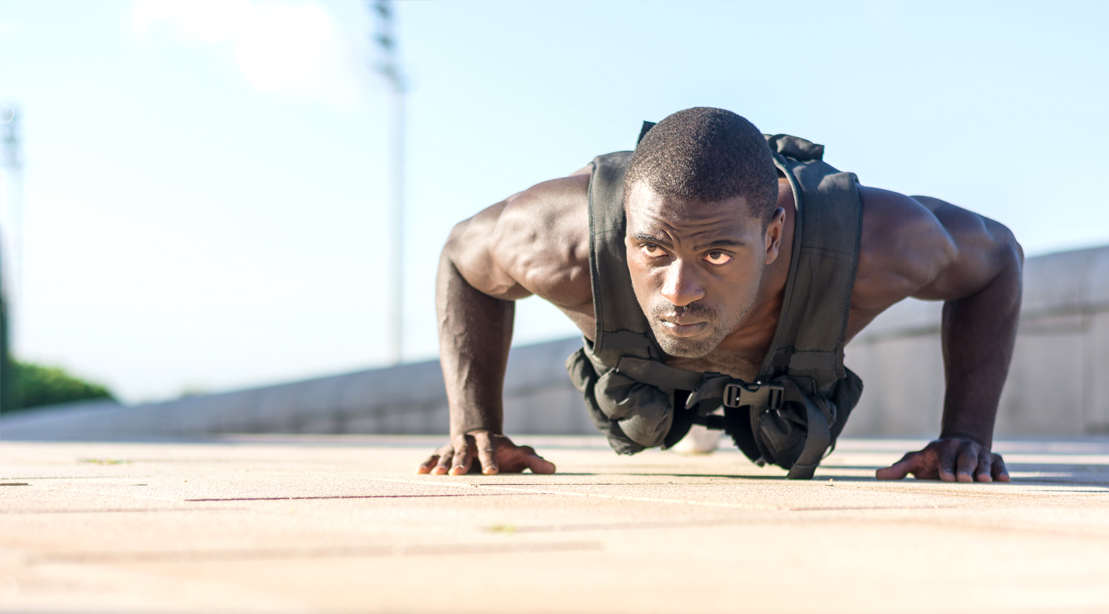28-Days-to-Lean Meal Plan
With the right plan and the right discipline, you can get seriously shredded in just 28 days.
Read article
Many lifters discount bodyweight training because are few ways to progress bodyweight training besides adding more sets and reps, reducing stability, and increasing complexity. Plus, it’s challenging to train your upper and lower back without a chin-up bar.
Progress is the name of the gym game; most will blow it off when they see no way to progress with a bodyweight exercise or training. Discounting bodyweight exercises is a real shame because you’ll be missing out on all the benefits, including
Training with body weight makes you more aware of your body’s position in space (proprioception), which leads to improved balance and being a better athlete. Here we’ll dive into three ways to progress your bodyweight training so you will not be so quick to discount it.
Often, lifters rush their bodyweight exercises to get it over and done with, so they can get to their mirror bicep curls. Who doesn’t like watching their biceps swell up in the mirror with every rep? Not this guy.
But by NOT rushing through bodyweight exercises, you can take advantage of a prime opportunity in progression, time under tension. Slowing down or adding pauses into your bodyweight exercises increases your muscle’s time under tension (TUT), potentially leading to more muscle growth.
Every exercise has four rep parts: the eccentric or lowering portion, the stretched position, the concentric or lifting piece, and the lockout. Changing how long each part takes is called tempo lifting, and it can be the key to adding more muscle when training with body weight.
For example, perform a pushup with a 3-3-3-3 tempo. This means you take three seconds to lower, hold a three-second pause, lift in three seconds, and pause for three seconds in the contracted position. By doing this, you will never look at push-ups as being too easy again.
The second is adding a pause in the most challenging position of an exercise, like the bottom of a push-up, when your knee hovers over the ground with a split squat or holding the top of a chin up. You perform the rest of the exercise like normal, which adds more TUT and makes the rest of the repetition parts more difficult.
Adding resistance is always the name of the game with progression. Still, you want to take a goldilocks approach when progressing your bodyweight training with load (minus free weighted exercise with dumbbells, barbells, and kettlebells).
Not too cold, not too hot, ooh, just right.
Two ways you can do this are using a weighted vest and wearing resistance bands. Let’s explore the weight vest.
Weighted vests are worn around your torso and shoulder area, and then two main types are one which you can add to your weight or one where the weight is already pre-determined. The vest’s weight varies, but the typical commercial-grade vest ranges from 12–150 pounds.
Weighted vests are a great way to progress your bodyweight movements and can be used with some aerobic activities, such as walking and hiking. Plus, if you’re interested in getting more explosive and powerful, they can be used during your plyometric training, plyo, including jumps and push-ups, and reactive training drills.
When using a weighted vest, start with no extra weight in the vest, and progress slowly when you get stronger and more confident. Make sure the added weight doesn’t impede good form. As a general rule for safety, depending on your strength and training experience, use no more than 10% of your body weight. So, if you weigh 200 pounds, don’t exceed 20 pounds on the vest.
WearBands is a tool where you attach light resistance bands to your hands and feet and anchor them to a belt you wear around your waist. They are used by college programs and professional athletes to improve their conditioning and movement to prepare them for what happens in the sporting arena.
For the rest of us, this system is a fantastic way to add light resistance to bodyweight movements like squats, lunges, and push-ups. Plus, like the weighted vest, you can use them to add a little juice to your conditioning drills and plyometric exercises.
By wearing resistance bands during regular bodyweight movements, you recruit and activate more muscle over just body weight.
According to WearBands™, “The resistance anchor points allow complete freedom of movement in a biomechanically sound fashion, making it a piece of resistance equipment that can enhance virtually any workout.”
Like the weighted vests, you must be wary that the added resistance doesn’t impede your movement and technique but enhances it. With both the bands and weighted vest, some experimentation is required to get the goldilocks effect.